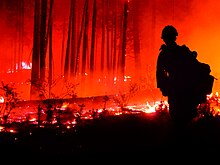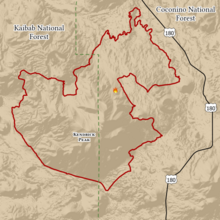
The Mogollon Rim is a topographical and geological feature cutting across the northern half of the U.S. state of Arizona. It extends approximately 200 miles (320 km), starting in northern Yavapai County and running eastward, ending near the border with New Mexico. It forms the southern edge of the Colorado Plateau in Arizona.

The Coconino National Forest is a 1.856-million acre United States National Forest located in northern Arizona in the vicinity of Flagstaff, with elevations ranging from 2,600 feet to the highest point in Arizona at 12,633 feet. Originally established in 1898 as the "San Francisco Mountains National Forest Reserve", the area was designated a U.S. National Forest by Pres. Theodore Roosevelt on July 2, 1908, when the San Francisco Mountains National Forest Reserve was merged with lands from other surrounding forest reserves to create the Coconino National Forest. Today, the Coconino National Forest contains diverse landscapes, including deserts, ponderosa pine forests, flatlands, mesas, alpine tundra, and ancient volcanic peaks. The forest surrounds the towns of Sedona and Flagstaff and borders four other national forests; the Kaibab National Forest to the west and northwest, the Prescott National Forest to the southwest, the Tonto National Forest to the south, and the Apache-Sitgreaves National Forest to the southeast. The forest contains all or parts of nine designated wilderness areas, including the Kachina Peaks Wilderness, which includes the summit of the San Francisco Peaks. The headquarters are in Flagstaff. The Coconino National Forest consists of three districts: Flagstaff Ranger District, Mogollon Rim Ranger District, and Red Rock Ranger District, which have local ranger district offices in Flagstaff, Happy Jack, and Sedona.

Kendrick Peak or Kendrick Mountain is one of the highest peaks in the San Francisco volcanic field north of the city of Flagstaff in the U.S. State of Arizona and is located on the Coconino Plateau in Coconino County.
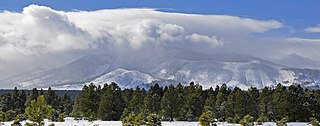
Kendrick Mountain Wilderness is a 6,510-acre (26.3 km2) wilderness area in the U.S. State of Arizona. It lies north of the city of Flagstaff on the Coconino Plateau in Coconino County. Kendrick Mountain Wilderness was designated a protected Wilderness area by Congress in 1984. About two thirds of the wilderness is contained within the Kaibab National Forest. Kendrick Mountain Wilderness contains 10,418-foot (3,175 m) Kendrick Peak, upon which a fire lookout has been located since the early 1900s.

Oak Creek Canyon is a river gorge located in northern Arizona between the cities of Flagstaff and Sedona. The canyon is often described as a smaller cousin of the Grand Canyon because of its scenic beauty. State Route 89A enters the canyon on its north end via a series of hairpin turns before traversing the bottom of the canyon for about 13 miles (21 km) until the highway enters the town of Sedona.

The Schultz Fire was a wildfire which burned over 15,000 acres (6,100 ha), including Schultz Peak in Coconino National Forest near Flagstaff, Arizona, in June 2010. The suspected cause is a campfire left unattended, and the United States Forest Service is offering a $2500 reward for information.
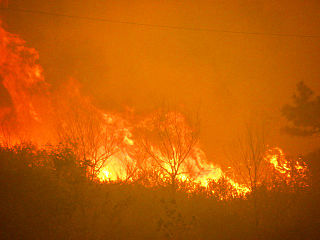
The 2012 Colorado wildfires were an unusually devastating series of Colorado wildfires, including several separate fires that occurred throughout June, July, and August 2012. At least 34,500 residents were evacuated in June.

The 2014 King Fire was a large wildfire in El Dorado County, California, which burned 97,717 acres primarily in the Eldorado National Forest. The wildfire started on September 13, 2014, near Pollock Pines, California, to the east of Sacramento. The ensuing fire suppression effort, which cost more than $100 million and engaged more than 8,000 personnel at its peak, allowed for the full containment of the King Fire by October 9, 2014. Despite the size and ferocity of the fire, it caused no deaths. Eighty structures were destroyed, the majority of them outbuildings. The King Fire was determined to have been caused by an act of arson and a suspect was swiftly apprehended and convicted in 2016.

The Tinder Fire was a wildfire that burned 16,309 acres (6,600 ha) of the Coconino National Forest in the U.S. state of Arizona during April and May 2018. The fire was detected by a United States Forest Service (USFS) lookout tower on April 27, 2018, and firefighters began working to contain its spread within the day. Benefiting from strong winds, low humidity, and high temperatures, the fire grew rapidly over late April, prompting the closure of Arizona State Route 87 and evacuation orders for 1,000 houses in Coconino County. These orders remained until May 4. Almost 700 firefighters were involved in combating the fire, which was fully contained on May 24. The investigation into the fire determined that the Tinder Fire was caused by a prohibited campfire.

The Rattlesnake Fire was a wildfire that burned 26,072 acres (10,551 ha) in Navajo and Greenlee Counties, in Arizona. The fire was detected on April 11, 2018, on the Fort Apache Indian Reservation and spread onto the San Carlos Indian Reservation and Apache-Sitgreaves National Forests over the following four days. Fanned by high winds, the Rattlesnake Fire spread rapidly until it was contained on May 1. The fire continued to burn within containment until May 27. No structures were damaged or destroyed by the fire, but 15 firefighters were injured. Investigators suspected the cause of the fire was human activity, but it was never determined with certainty.

The El Dorado Fire was a wildfire that burned 22,744 acres in San Bernardino and Riverside counties of California from September to November 2020. It was ignited on September 5 by a pyrotechnic device at a gender reveal party in El Dorado Ranch Park; it quickly spread to the San Gorgonio Wilderness Area of the San Bernardino National Forest. Burning over a 71-day period, the fire destroyed 20 structures and resulted in one firefighter fatality, for which the couple hosting the party were charged with involuntary manslaughter.

The Goodwin Fire was a wildfire that burned 28,516 acres (11,540 ha) in the U.S. state of Arizona over 16 days, from June 24 to July 10, 2017. The fire destroyed 17 homes and damaged another 19 structures, but no firefighters or civilians were injured or died in the fire. Investigators did not determine any particular cause for the fire.

The 2021 Arizona wildfire season was a series of wildfires that burned across the state of Arizona, United States. Wildfires across the state burned 524,428 acres (212,228 ha) of land in at least 1,773 fires throughout the state, fueled in part by a drought, hot temperatures, and thunderstorms producing dry lightning. At one point in late June, over 20 active wildfires were burning across the state.

The Sawmill Fire was a wildfire that burned 46,991 acres (190 km2) in the U.S. state of Arizona in April 2017. The fire was caused by the detonation of a target packed with Tannerite at a gender reveal party in the Coronado National Forest. No injuries or fatalities resulted from the fire, nor were any buildings destroyed, though the fire did come close to the historic Empire Ranch, a National Register of Historic Places property. Over 800 personnel from various federal, state, and local agencies and organizations worked to contain and then extinguish the Sawmill Fire at a cost of $8.2 million.
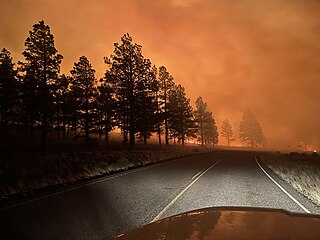
The Tunnel Fire was a wildfire burning in Coconino National Forest and Sunset Crater Volcano National Monument, the Lack Bill Park neighborhood north of the city of Flagstaff, Arizona in the United States, and along U.S. Route 89. The fire was named after a tunnel landmark on Waterline Road, near where it ignited on Sunday, April 17, 2022. On June 3, 2022, the wildfire was declared 100% contained by AZIEN. It had burned 26,532 acres and had destroyed 30 homes. No fatalities or injuries were reported.
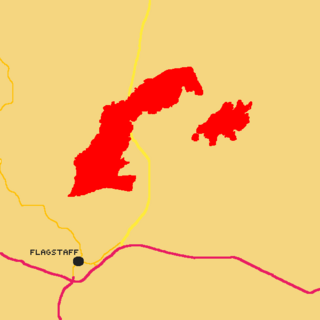
The June 2022 Flagstaff wildfires was a series of wildfires burning near the city of Flagstaff, Arizona. At least three wildfires were reported near Flagstaff and caused hundreds of people to evacuate. However, two of the three reported fires, which are the Haywire and Double fires, combined on June 13. Before the merger of both of the fires, the Double Fire burned 500 acres (200 ha). The first wildfire to be discovered was the Pipeline Fire on June 12 at around 10:15 AM (MST); By Monday evening on June 13, the fire burned 5,000 acres (2,000 ha). As of June 13, 2022, no injuries or deaths have been reported, and one structure has been destroyed.

The Frye Fire was a wildfire that burned 48,443 acres (19,604 ha) in Graham County, Arizona, United States, from June 7 to September 1, 2017. The fire was ignited by a lightning strike on Mount Graham, within the Coronado National Forest, and spread rapidly until it was mostly contained on July 12. The Frye Fire destroyed three buildings, briefly threatened the Mount Graham International Observatory, cost $26 million to contain and suppress, and involved more than 800 firefighters. There were no fatalities, but 63 firefighters were quarantined as a result of a strep throat outbreak.
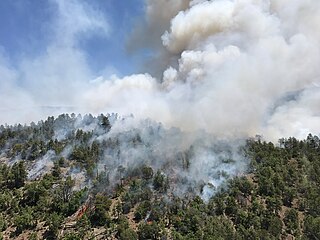
The Snake Ridge Fire was a wildfire that burned 15,333 acres (62.05 km2) of the Coconino National Forest in the U.S. State of Arizona. The fire was ignited by a lightning strike on May 19, 2017, as the United States Forest Service (USFS) was conducting controlled burns within the Coconino National Forest to reduce the severity of future wildfires in the area. The USFS decided to manage the Snake Ridge Fire, named after the feature where the fire was ignited, as a controlled burn. Firefighting efforts focused on protecting infrastructure by burning fuels near power lines. These burns were completed on June 4 and the USFS subsequently allowed the fire, which had by this time been surrounded by firebreaks, to burn out. The fire was allowed to burn until July 13 and cost a total of $1 million to manage and contain. There were no serious environmental consequences as a result of the fire.
